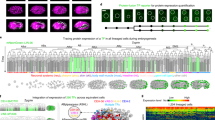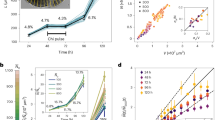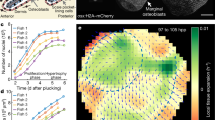Abstract
In animal development, the first tissues to be formed include such major components as muscle, nerve cord, notochord and the eye. In the vertebrates, all of these tissues are formed by embryonic induction, a process by which some of the cells within a mass of tissue are caused to change their direction of differentiation as a result of close proximity to cells of another kind1–3. The induced cells typically form a solid coherent mass with a distinct border between them and the remaining uninduced cells (Fig. 1a). This clean separation between induced and uninduced cells is much sharper than can readily be explained as a result of the induction process. We describe here the culture of amphibian cell and tissue recombinations in solid gels containing cytochalasin in which cell division and cell movement is inhibited during response to induction. This has revealed an effect in which the ability of a cell to respond to induction by differentiating as muscle is enhanced by, or even dependent on, other neighbouring cells differentiating in the same way at the same time. This seems to be a newly described process in animal development, termed the community effect. It helps to explain the formation of blocks of tissue from sheets of cells, and could be of widespread occurrence and significance in morphogenesis resulting from embryonic induction.
This is a preview of subscription content, access via your institution
Access options
Subscribe to this journal
Receive 51 print issues and online access
$199.00 per year
only $3.90 per issue
Buy this article
- Purchase on Springer Link
- Instant access to full article PDF
Prices may be subject to local taxes which are calculated during checkout
Similar content being viewed by others
References
Saxen, L. & Toivonen, S. Primary Embryonic Induction (Academic, New York, 1962).
Kratochwil, K. in Cell Interactions and Development: Molecular Mechanisms (ed. Yamada, K. M.) 99–122 (Wiley, New York, 1983).
Gurdon, J. B. Development 99, 285–306 (1987).
Nieuwkoop, P. D. Wilhelm Roux Arch. 162, 341–373 (1969).
Nakamura, O., Takasaki, H. & Ishihara, M. Int. Proc. Jap. Acad. 47, 313–318 (1971).
Gurdon, J. B., Fairman, S., Mohun, T. J. & Brennan, S. Cell 41, 913–922 (1985).
Jonas, E. J., Sargent, T. D. & Dawid, I. B. Proc. natn. Acad. Sci. U.S.A. 82, 5413–5417 (1985).
Jones, E. A. & Woodland, H. R. Cell 44, 345–355 (1986).
Sargent, T. D., Jamrich, M. & Dawid, I. B. Devl Biol. 114, 238–246 (1986).
Smith, J. C. & Malacinski, G. M. Devl Biol. 98, 250–254 (1983).
Kintner, C. R. & Brockes, J. P. Nature 308, 67–96 (1984).
Gurdon, J. B. Development (in the press).
Sporn, M. B. & Roberts, A. B. Nature 313, 745–747 (1985).
Metcalf, D. Proc. R. Soc. B 230, 387–423 (1987).
Farrar, J.-J. et al. Immun. Rev. 63, 129–166 (1982).
Mangold, O. & Spemann, H. Wilhelm Roux Arch, Entw Mech. Org. 111, 341–422 (1927).
Muchmore, W. B. J. exp. Zool. 134, 293–313 (1957).
Grunz, H. Wilhelm Roux Arch. dev. Biol. 187, 49–57 (1979).
Nevo, Z. & Dorfman, A. Proc. natn. Acad. Sci. U.S.A. 69, 2069–2072 (1972).
Meier, S. and Hay, E. D. Devl Biol. 38, 249–270 (1974).
Symes, K., Yaqoob, M. & Smith, J. C. Development (in the press).
Heasman, J., Wylie, C. C., Hausen, P. & Smith, J. C. Cell 37, 185–194 (1984).
Priess, J. R. & Thomson, J. N. Cell 48, 241–250 (1987).
Martinez-Arias, A., Baker, N. E. & Ingham, P. W. Development 103, 157–170 (1988).
Le Douarin, N. Cell 38, 353–360 (1984).
Gurdon, J. B. Development (submitted).
Author information
Authors and Affiliations
Rights and permissions
About this article
Cite this article
Gurdon, J. A community effect in animal development. Nature 336, 772–774 (1988). https://doi.org/10.1038/336772a0
Received:
Accepted:
Issue Date:
DOI: https://doi.org/10.1038/336772a0
This article is cited by
-
Intercellular exchange of Wnt ligands reduces cell population heterogeneity during embryogenesis
Nature Communications (2023)
-
Cadherins in early neural development
Cellular and Molecular Life Sciences (2021)
-
You should always keep in touch with your friends: Community effects in biology
Nature Reviews Molecular Cell Biology (2020)
-
Signal Propagation in Sensing and Reciprocating Cellular Systems with Spatial and Structural Heterogeneity
Bulletin of Mathematical Biology (2018)
-
Lung Organoids and Their Use To Study Cell-Cell Interaction
Current Pathobiology Reports (2017)
Comments
By submitting a comment you agree to abide by our Terms and Community Guidelines. If you find something abusive or that does not comply with our terms or guidelines please flag it as inappropriate.



